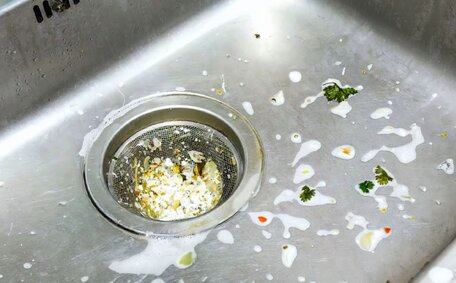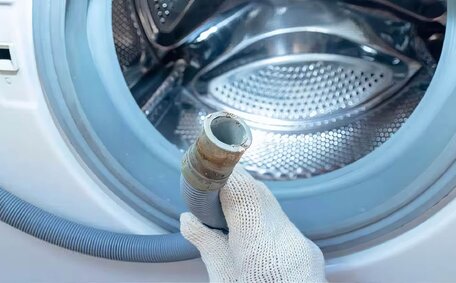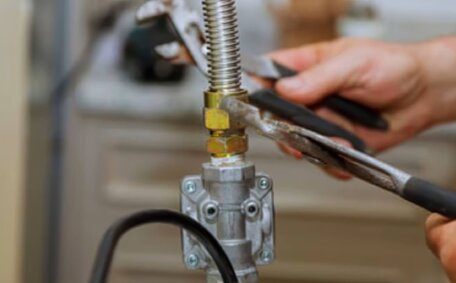Understanding Why Pipes Freeze
Dropping temperatures cause water within pipes to freeze and expand, threatening your plumbing system. This expansion puts intense pressure on rigid pipes, pressure that can cause pipe to crack and burst. Burst fixtures from frozen pipes can lead to flooding, causing considerable property damage and health hazards.
Water pipes in uninsulated walls or exposed to cold air are highly susceptible to freezing.
Crawl spaces, garages, and attics are common problem areas where a pipe inside your home may have freezing issues.
Understanding why and where pipes may freeze is crucial for developing strategies to prevent frozen bursts. Sealing air gaps and insulating pipes in susceptible areas effectively prevent freezing.
Knowing the Signs of Frozen Pipes
Here are key signs to identify frozen pipes and tips to prevent them:
- A clear sign of frozen pipes is no water output from faucets or showerheads, regardless of how many taps are turned on.
- Visible frost or ice buildup on the outside or inside of pipes.
- Strange metallic creaking or groaning sounds coming from pipes.
- Low water pressure or uneven flow - just a trickle despite the faucet turned fully on.
- Toilets won’t flush properly.
Noticing these signs early on can prompt fast action, and an appropriate attempt to thaw a section pipe can avert structural damage to your home. Attempting to thaw pipes once they’ve experienced a burst pipe leaves you vulnerable to flooding, significant water leakage into your walls and floors, and costly repairs. Proactively detecting and addressing conditions that indicate potential freezing is essential.
Prevention is best, but recognising imminent frozen pipes can mitigate considerable costs in insurance claims. If you notice early ice formation, take immediate corrective action - consult tips for warming pipes to address the issue. Apply heat to correct the issue and contact professional plumbers if unsure how to safely thaw your pipes.
Preventing Pipes from Freezing
Here are practical measures to prevent your pipes from freezing during cold weather:
- Insulate any pipes, including hose bibs, that are absent from the reach of your heating system and situated within the walls of your home, such as those in crawl spaces, attics, and garages. Do use pipe wrap, foam tubing, or fibreglass insulation to protect your exposed pipes from the cold.
- Seal any air leaks and gaps in insulation around pipes as a method of how prevent your pipes from freezing. Even small openings let freezing air into the pipe surroundings.
- Maintain your home’s temperature at a minimum of 15°C to shield your water pipes from freezing, even when you’re away.
- During extremely cold weather, open kitchen and bathroom cabinet doors to let warm air circulate around the pipes your home contains.
- Consider installing heat tape or heat cables as measures to keep water from freezing in areas where your pipes are vulnerable. Choose UL-approved methods specifically designed to keep pipes warm; it’s good practice to heed the accompanying directions meticulously.
- Keep running water continuously with a thin trickle from faucets to reduce the likelihood of freezing. This continual water motion through your taps exemplifies things can do to prevent internal pipe ice formations from developing.
- Know where your main valve is and how to turn off the water supply if pipes do start to freeze, to prevent potential damage.
Older homes with plumbing in uninsulated walls, attics, or crawl spaces are at higher risk of pipe freezing. However, vigilant sealing of air gaps and maintaining air circulation can effectively prevent pipes from freezing.
Noticing reduced water pressure or similar freezing signs, it’s vital to act quickly and call a plumber. Rapid response can frequently prevent a pipe burst event.
Insulating Vulnerable Pipes
Pipes located in places they’re likely to freeze, such as along exterior walls or in unheated spaces like garages or attics, are highly susceptible to freezing. Focusing your insulation efforts on these pipes is key to preventing freezes.
The best way to insulate susceptible pipes is by wrapping them with specially designed pipe insulation products. Fibreglass and foam pipe insulations are readily available from hardware stores. Make sure you select the right-sized insulation for your pipes, offering essential protection against freezing.
In tackling larger water conduits, mounting heat cables or tape along the entire span of a pipe can ensure a frozen pipe can’t easily establish itself. These electric products, which encircle the pipe, provide enough warmth to maintain a consistent flow of warm water, preventing freezing.
Sealing any air gaps around any pipes with the aid of caulk or spray foam is also critical. This protects the insulation’s effectiveness and prevents cold drafts from reaching the pipe surface.
Well-insulated pipes are a cornerstone of preventing situations where water freezes in the plumbing, considerably reducing the likelihood of freezing even during cold snaps. Preventing plumbing freezes involves nuances such as keeping indoor heat constant and allowing faucets to drip, adding an additional defence layer.
If the task is beyond your comfort zone and you’d rather not do your own insulation, hire a professional plumber to insulate pipes in awkward crawl space locations. They can custom fit the right insulation products for your home’s layout.
Keeping a Consistent Temperature
Ensuring that your home can maintain a consistent temperature around 15°C or above is vital for the well-being of your plumbing system and in averting frozen pipes. When it’s very cold outdoors, the wider the gap between indoor and outdoor temperatures, the lower the chances your pipes will freeze.
Use your thermostat to keep home temperatures sufficiently warm. A programmable thermostat can regulate your home’s climate for warmth and energy efficiency. Make sure it never dips below 13°C even while vacant.
Close garage doors to retain warmth if your water supply lines pass through and consider insulating or heating those pipes. Opening kitchen and bathroom cabinets also allows warmer indoor air to reach pipes.
Monitoring your home’s temperature and adjusting your thermostat to maintain a warm, consistent climate can help curtail the chances of pipes freezing in winter.
Letting Faucets Drizzle
A slow drip from faucets during extremely cold weather helps prevent pipe freezing. During freezing conditions, a regulated, minimal drip can also ensure water can continuously move within the pipes, thwarting ice formation. This makes it harder for the frigid temperatures to cause pipes to freeze and result in an ice blockage.
Ensure the drip is constant and adjust the flow to prevent water wastage.
Even just a faint drip created when you turn faucet can significantly diminish the freeze risk for your property. Configure the faucet so that it drips every 3-5 seconds. Prioritise faucets on outside walls or in unheated areas like garages.
Also open kitchen and bathroom cabinet doors underneath sinks, especially if there’s a frozen section of pipe you’re concerned about. This allows warmer indoor air to circulate around pipes, offering additional freeze protection. Consider investing in foam pipe insulation or heat cables for vulnerable pipes in these cold-prone areas as well.
By keeping water flowing at an even pace inside pipes via faucet drips, you help keep water from stagnating and freezing, significantly reducing the risk of ice blockages. Combined with heat sources and insulation, it’s a simple but highly effective winterization tactic.
Thawing Frozen Pipes
If you detect signs of frozen pipes, Swift measures are imperative to cut out your risks when pipes burst, circumventing significant water damage. There are several safe methods you can do prevent your pipes from reaching the critical point of thawing them yourself:
- Utilise a hairdryer on its highest setting, focusing on the frozen area of the pipe to gradually restore water flow. Sweep the warmth to and fro along the length pipe, easing the icy grip bit by bit to reinstate fluid movement. This gradual heating of the pipe can melt the ice, restoring pipe water flow from the outside-in.
- Envelop segments of a frozen pipe with a heating pad or use a heat lamp near frozen pipe segments for a proficient thawing process. Monitor temperatures and remove once water starts flowing again. Never leave unattended or let pipes get too hot.
- The warmer indoor air circulating around pipes can help thaw them from the outside.
- Consider draining and executing a shut off water procedure at your home’s main valve if the efforts to thaw your pipes don’t produce results after 30 minutes. This minimises water release in your house if bursting still occurs.
Make sure to call your plumber right away if pipes have already burst or if you can’t restore water flow because you must never apply an open flame or hazardous methods to thaw pipes. For severe freeze events, professionals offer expert advice and use specialised heating equipment and pipe de-icing chemicals.
Opt away from potentially perilous methods, and never use open flames or overly hot water as quick fixes for thawing: these can escalate bursting dangers arising from rapid temperature surges. Thaw frozen pipes gradually instead, stopping immediately if cracks, leaks or bursts happen.
Using Portable Heaters
Portable electric heaters can be an efficacious strategy to gently warm up and thaw frozen pipes. Position the heater 2-3 feet away, pointing the heat flow along the pipe’s length. Monitor temperatures closely using a digital thermometer and remove the heater to keep water from freezing once readings hit 10°C.
Going above 50°C risks overheating and bursting.
When it comes to using any heating implement on pipes, upholding home safety takes precedence.
Choose an appliance with auto shut-off tip protection to prevent fire hazards if knocked over. Ensure the heater, pipe, and surrounding area are free of moisture and debris. Never leave portable heaters unattended - check frequently for signs of melting or leaks.
For awkward areas like crawl spaces, Consider using space heaters on a stand for directional warmth to coax warmth into the areas where pipes are likely to freeze. This focuses heat directionally while minimising ambient temperature increase in enclosed spaces with insulation risks. Always follow individual appliance safety guidelines and redirect heat immediately if plastic materials or wiring are nearby.
With proper placement and vigilant monitoring, portable electric heaters offer localised heat to thaw pipes and prevent frozen water gradually from the outside. Preventing overheating reduces burst risks once flow is restored.
Applying Heat Tape
Heat tape is a piece of equipment that can protect them by insulating your frozen pipes from the bitterness of winter. It consists of an electrical heating element inside a plastic wrap that affixes directly onto pipes. When activated, the heat tape warms any pipes enough to keep them from reaching temperatures that can cause pipes to freeze.
Use heat tape designed for plumbing with integrated thermostats for temperature regulation. This allows the heat level to adjust to ambient temperatures.
Most types simply plug into a nearby outlet. Use a ground-fault interrupter outlet for safety near water sources.
While useful for freeze protection, heat tapes have some fire risks requiring vigilance. Check regularly that contacts on the pipe are sound, no sections lift away from pipes allowing gaps, and that the heating elements don’t feel too hot.
Used responsibly, heat tape safely warms pipes just above freezing, especially during winter months. Combined with pipe insulation like fibreglass wraps, heat tape keeps vulnerable water lines flowing even during cold snaps. Adhering to the guidelines, attend to any maintenance needs promptly, substituting any fractured or impaired parts to prevent situations where a pipe bursts.
When to Call a Professional Plumber
Knowing how to deal with frozen pipes, including when to call a professional plumber, is crucial for effective management. Blacktown Plumbing’s team of licensed plumber experts possess the expertise, specialised heaters, and appropriate substances to swiftly tackle emergencies with iced-up pipes.
Specifically, reach out for emergency assistance if:
- Pipes have already burst and are leaking water
- Attempted pipe thawing efforts over 30+ minutes made no progress
- Pipes are located in hard-to-access areas like crawlspaces
- You have no way to access or isolate your main water valve
- Significant water damage has already occurred around pipe locations
Discover how our team is on call 24/7 to quickly respond to frozen pipes that threaten your home’s integrity. Call 1300 349 338 or email jobs@blacktownplumbingservices.com.au for urgent help preventing further water leakage and pipe damage.
We offer emergency leak detection, pipe repairs, water extraction/drying services, mould remediation, and full home repairs stemming from burst pipes. Don’t wait until it’s too late - our swift response can drastically reduce repair costs and property damage.






